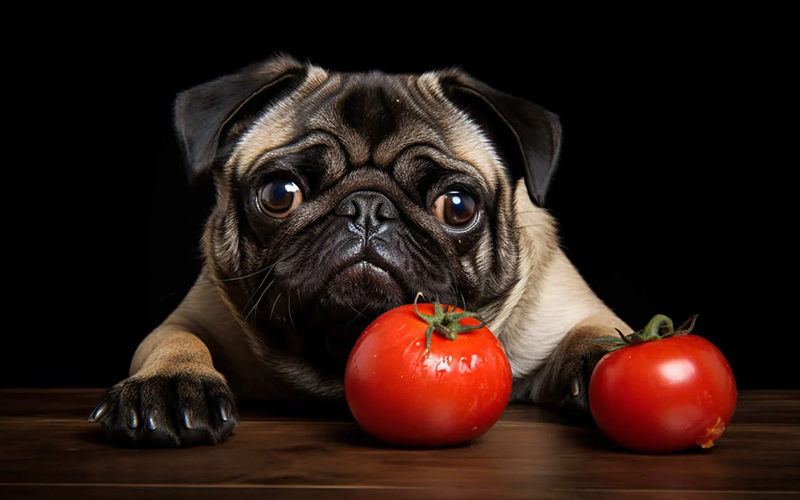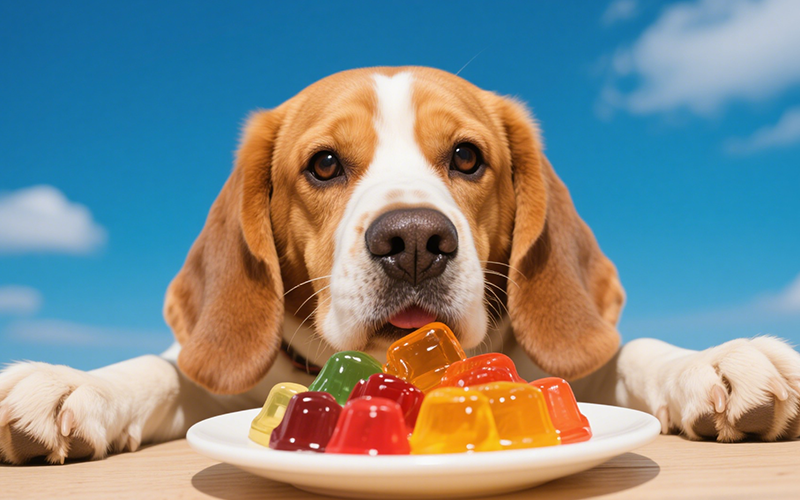Can Dogs Eat Tomatoes? A Complete Guide to the Benefits and Risks
- 14 Feb 2025 15:39
Tomatoes are a popular fruit (often mistaken for a vegetable) that many people enjoy in salads, sauces, and dishes. If you're a dog owner, you might wonder if it's safe to share a piece of your tomato with your dog. While tomatoes are not toxic in small amounts, there are certain precautions you should take when feeding them to your dog. In this article, we’ll explore whether tomatoes are safe for dogs, their benefits, potential risks, and how to serve them safely.

Are Tomatoes Safe for Dogs?
Tomatoes, particularly ripe, red tomatoes, are generally safe for dogs to eat in small amounts. However, unripe tomatoes, tomato plants, and the green parts of the tomato, such as the leaves and stems, contain a toxic substance called solanine. Solanine can cause a variety of health issues in dogs if ingested in large quantities.
In general, feeding small amounts of ripe tomatoes to your dog is safe, but you must take care to avoid the green parts and unripe tomatoes, which can be dangerous.
Nutritional Benefits of Tomatoes for Dogs
If served properly, tomatoes can offer several nutritional benefits for dogs:
Vitamins: Tomatoes are a great source of Vitamin C, which helps boost the immune system and supports healthy skin. They also contain Vitamin A, which is important for eye health, and Vitamin K, which helps with blood clotting and bone health.
Antioxidants: Tomatoes are rich in lycopene, an antioxidant that has been shown to help reduce inflammation and protect against oxidative stress. Lycopene may also support heart health and reduce the risk of cancer in dogs.
Fiber: Tomatoes contain dietary fiber, which aids in digestion and can help regulate your dog’s bowel movements. This can be beneficial for dogs that suffer from constipation or other mild digestive issues.
Low in Calories: Tomatoes are low in calories and fat, making them a healthy treat option for dogs, especially those that need to maintain a healthy weight.
Hydration: Since tomatoes are made up of about 95% water, they can help keep your dog hydrated, especially during hot weather.
Potential Risks of Feeding Tomatoes to Dogs
While tomatoes offer some health benefits, there are certain risks you should be aware of:
Toxicity from Green Parts: The green parts of the tomato plant, including the stems and leaves, contain solanine, which is toxic to dogs. If ingested, solanine can cause symptoms such as vomiting, diarrhea, lethargy, and confusion. If your dog eats unripe tomatoes or any part of the plant, it’s important to monitor them closely and seek veterinary attention if necessary.
Gastrointestinal Upset: While ripe tomatoes are generally safe, they can cause stomach upset in some dogs, particularly if fed in large amounts. Too many tomatoes can lead to vomiting, diarrhea, or bloating, especially in dogs with sensitive stomachs.
Allergic Reactions: Some dogs may have an allergy to tomatoes, though this is rare. Signs of an allergic reaction can include itching, swelling, or gastrointestinal issues. If you notice any unusual symptoms after your dog eats tomatoes, discontinue feeding them and consult a professional.
Overfeeding: Tomatoes should only be given as an occasional treat and not make up a significant portion of your dog’s diet. Too many tomatoes can cause digestive problems due to the acidic nature of the fruit.
How to Safely Serve Tomatoes to Dogs
To safely serve tomatoes to your dog, follow these tips:
Remove the Green Parts: Always ensure that the tomato is ripe and remove any green parts—including the leaves, stems, and unripe sections—before offering it to your dog. These parts contain solanine, which can be harmful to your pet.
Serve in Moderation: Tomatoes should only be an occasional treat for your dog. Offer a small amount to see how your dog reacts, and keep it as an infrequent snack rather than a regular part of their diet.
Cut Into Small Pieces: Slice the tomato into small, manageable pieces that are easy for your dog to chew. This is particularly important for small dogs, who may struggle with larger chunks.
Avoid Tomato Sauce or Seasoned Products: Avoid feeding your dog processed tomato products, such as tomato sauce, ketchup, or salsa, as they often contain added sugars, salt, and spices that can be harmful to dogs. Stick to fresh, plain tomatoes when offering them to your pet.
Monitor for Reactions: Keep an eye on your dog for any signs of gastrointestinal upset or allergic reactions after eating tomatoes. If you notice any unusual symptoms, discontinue feeding tomatoes and consult a health professional.
How Much Tomato Can Dogs Eat?
Tomatoes should only be given as an occasional treat and in moderation. The exact amount will depend on your dog’s size, but as a general guideline:
Small dogs: A small slice or a few bite-sized pieces (about 1/4 to 1/2 of a medium-sized tomato).
Medium dogs: A few small slices (about 1/2 to 1 medium-sized tomato).
Large dogs: Up to 1 medium-sized tomato or a handful of small pieces.
Remember, treats—including tomatoes—should make up no more than 10% of your dog’s daily caloric intake. The majority of their nutrition should come from their regular, balanced dog food.
Conclusion
In conclusion, tomatoes are generally safe for dogs to eat in small, controlled amounts, as long as they are ripe and the green parts are removed. They offer several nutritional benefits, including vitamins, fiber, and antioxidants, and can be a low-calorie, hydrating treat for your dog. However, it’s essential to avoid giving your dog unripe tomatoes or any part of the tomato plant, as these contain solanine, which can be toxic.
If you’re looking for an easy way to monitor your dog’s health and ensure they’re eating the right foods, consider using PettureX, a pet AI software that offers 24-hour online consultations and pet image recognition. PettureX can help you keep track of your dog’s health, diet, and behavior, ensuring they stay happy and healthy.
By following these guidelines and offering tomatoes as an occasional treat, you can safely include this nutrient-rich fruit in your dog’s diet, while keeping them safe and healthy.
Related

Can Dogs Eat Peaches? Vet Explains Benefits, Cyanide Risks & Safe Serving
- 16 Apr 2025
Can Dogs Eat Mulberries? Vet Explains Safety, Benefits & Potential Risks
- 16 Apr 2025
Can Dogs Eat Mozzarella? Vet Explains the Cheesy Truth (Risks & Benefits)
- 16 Apr 2025
Can Dogs Eat Mango Skin? Vet Explains Why It's a Risky Chew!
- 16 Apr 2025
Can Dogs Eat Maple Syrup? The Sugary Truth & Why Vets Advise Against It
- 16 Apr 2025
Can Dogs Eat Mac n Cheese? Vet Explains Why This Comfort Food Is Unsafe!
- 16 Apr 2025
Can Dogs Eat Liver? Vet Guide to This Nutrient-Dense Organ Meat (Benefits & Risks!)
- 16 Apr 2025
Can Dogs Eat Licorice? The Sweet Danger & Glycyrrhizin Risk Explained by Vets
- 16 Apr 2025
Can Dogs Eat Lamb? Vet Insights on This Nutritious Meat Option
- 16 Apr 2025
Can Dogs Eat Jelly? The Sweet Truth About Sugar, Xylitol & Why Vets Say No!
- 16 Apr 2025
